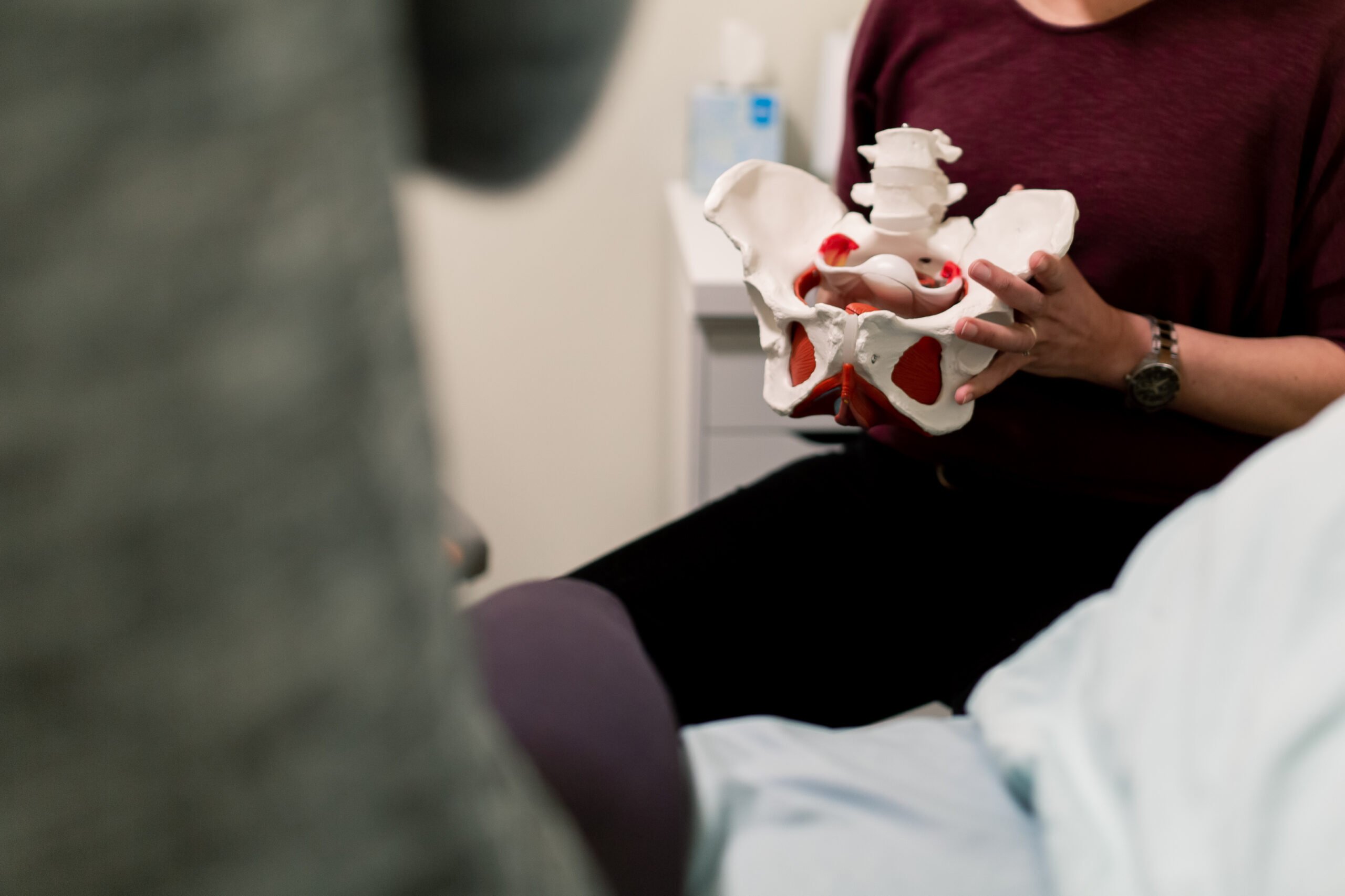Has your doctor mentioned ‘pelvic floor surgery’ during a recent appointment?
If you’re considering surgery for a weak pelvic floor, you’re not alone. According to a 2018 poll performed by the University of Michigan, 43% of women in their fifties and sixties said they’d experienced the leaks associated with urinary incontinence. 51% of women ages 65 and older reported the same.
The real numbers are likely far higher. After all, discussing dribbles with your doctor can feel embarrassing. (The poll confirmed this: two-thirds of the surveyed women hadn’t brought the issue up to a physician.)
Although there are ways to work towards healthier pelvic floor function, many simply accept leaks and dribbles as a normal part of life. Women cope on their own, using absorbent pads, wearing dark clothing to hide any leaks, keeping a mental map of available restrooms wherever they go, or even dehydrating themselves to avoid an accident in public.
These less-than-enjoyable practices don’t have to be inevitable. There are ways we can treat little leaks and restore a sense of control over our bodies.
Usually, the medical profession addresses this issue with medication or surgery.
Why Do Women Turn to Pelvic Floor Surgery?
After a woman has gone through menopause, pregnancy, or past surgeries in the pelvic floor area, she might experience a general loosening of the perineal area.
Anything that affects those muscles and nerves could also affect a woman’s natural ability to control bladder function and experience pleasure.
Surgery can initially seem like an effective one-and-done response to these issues, especially if you’re dealing with any of the following:
- Dribbles
- Leaks
- Discomfort during sex
- Incontinence
- Constipation
- Prolapse
However, pelvic floor dysfunction surgery may also come with a lot of issues. As a result, many women are seeking alternatives to pelvic floor surgery.
Fortunately, a significantly less invasive option is available that many are turning to for natural therapeutic benefit. Performing regular Kegel exercises can help women keep their pelvic floors in good shape and reduce the likelihood of needing surgery.

However, you need to do Kegels correctly in order to see the benefits — and that’s far easier said than done.
The Yarlap Autokegel device is a natural form of pelvic floor rehabilitation that teaches your body to regain control without undergoing invasive procedures, such as pelvic floor surgery.
But before we discuss the benefits of the Yarlap Autokegel, let’s talk about the realities of pelvic floor procedures.
What is Pelvic Floor Dysfunction Surgery?
Pelvic floor surgery involves the repair of the muscles and tissues that comprise the pelvic floor — particularly, the muscles around the bladder.
There are a few different types of pelvic floor surgery options, or even bladder pacemaker surgery. (Yes, you read that right — there are bladder pacemakers, or devices geared to help control overactive bladders).
By far, the most common type of pelvic floor surgery involves the implantation of a ‘pelvic sling.’
This might work for a while, but it’s not a permanent option. Depending on a woman’s specific circumstances, this type of surgery may only last a handful of years — and may no longer be an option after a few attempts. These procedures can also lead to severe and painful complications.
A team of researchers at Cornell reported, “…that no amount of mesh is completely safe.” The same team also concluded, “But there is a ‘dose-response’ relationship, meaning the more mesh used, the more erosions or complications occur.”
In severe cases, a doctor may recommend pelvic organ prolapse surgery. Pelvic organ prolapse occurs when the pelvic floor muscles can’t support the pelvic organs (e.g., your bladder, urethra, uterus, etc.,). Pelvic organ prolapse surgery can involve pelvic floor reconstruction to help restore these organs to their original positions.
These operations can be very effective — but they can also be scary. Putting such an intimate part of yourself through an invasive procedure can be too much for some women. Unfortunately, these concerns aren’t without merit.
Even if they are ultimately successful, invasive surgeries can be associated with a lot of unwanted side effects.
The True Cost of Pelvic Floor Surgery
Aside from the emotional toll pelvic floor surgery can take on people, patients who go in for this type of procedure may also experience:
- Steep costs. While the price associated with every procedure will vary depending on location, insurance, providers, etc, pelvic floor surgery can easily cost thousands of dollars (some estimates fall between $7,000 and $12,000).
This sticker price doesn’t include the costs associated with preparing for the surgery or recovering from it, which could require time off work and expensive pain medication.
- Significant recovery time. As Brigham and Women’s Hospital puts it: “When you first come home, not every day will be a good day.” For weeks after surgery, you may experience low energy, fatigue, and even post-surgery depression.
For as long as six weeks after the operation, you may also experience bleeding and discharge. It can take months before you feel comfortable enjoying normal function again.
- Unpleasant side effects. Pelvic floor surgery isn’t without potential risks and complications. After the procedure is complete, many women experience a range of side effects, from constipation and pain during intercourse to the same leaks and dribbles that inspired the surgery in the first place.
In addition to all of these costs and complications, there’s the fact that pelvic floor surgery isn’t always effective. These surgeries have an approximate success rate of 70%-90%. Even if it does work for a time, there’s always a chance that symptoms will return later in life.

Pelvic floor dysfunction surgery can be invasive and painful — and it might not even work long-term. And yet, women turn to this solution frequently.
In the absence of a workable alternative, surgery may seem like the only option.
Fortunately, there are less drastic alternatives to explore.
Alternatives to Pelvic Floor Surgery
From medications to pads, pessaries, and Kegel exercises, women have accessible methods they can use to tackle the leaks and dribbles in their lives.
Medications to Treat Pelvic Floor Dysfunction
The number of prescription drugs available to treat overactive bladder symptoms is high. In fact, the market for overactive bladder pharmaceuticals is valued at $3 billion.
It’s not clear medication provides longer-lasting or better management for pelvic floor dysfunction, but the ease of administration can make a compelling case for prescription drugs.
As Amir Qaseem, vice president of clinical policy at the American College of Physicians, put it: “It’s easier to prescribe medications than to explain the non-pharmacological treatments.”
Some of the common medications prescribed to treat overactive bladder symptoms include tolterodine, oxybutynin, and solifenacin, among others. Taking these medications often seems like the simplest possible choice, and in some cases, it’s the best choice for the patient.
However, after being prescribed these drugs, half of the patient population stops taking them within six months.
The side effects associated with these drugs (including blurred vision, dry mouth, constipation, and dizziness, among even more severe long-term risks) can be a non-starter for many.
Ultimately, prescription drugs for overactive bladder and pelvic floor dysfunction tend to provide some moderate benefits but don’t work nearly as well as non-drug treatments.
Absorbent Pads and Discreet Disposables
If you thought the $3 billion overactive bladder pharmaceutical market was big, you haven’t seen anything yet.
The United States adult diaper, disposable underwear, and absorbent pad market is three times the size, with estimates averaging around $9 billion.
(It’s also growing: According to some, the adult incontinence market could reach $14 billion by 2025).
A woman seeking simple protection from dribbles while going about her day may spend hundreds of dollars annually on disposable pads. It doesn’t help that these diapers need to be changed on a frequent basis to avoid irritation of delicate tissues.
There are more sustainable options available, but these can require higher start-up investment (and more effort and upkeep — laundry, disinfection, storage, etc).
While the use of pads and adult diapers can be the easiest to implement, they’re expensive and can be embarrassing to discuss or purchase.
Additionally, adult diapers and pads are far from eco-friendly. As it turns out, adult disposable diapers make up over 17 million tons of garbage and constitute 7% of the nation’s landfill waste.
The Pros and Cons of Pessaries
Pessaries are small, removable devices women can place inside to support their pelvic organs. They can constitute one alternative to surgery, and they can help women control their symptoms or delay the requirement for more permanent decisions.
However, these devices aren’t perfect. They require a fitting with a doctor to be sure that the device fits each unique woman, so they aren’t as discreet as many women would prefer.

There’s also the distinct risk of bacterial infection, should the pessary become dirty or damaged.
While pessaries may be more eco-friendly, less expensive, and less dangerous than many alternatives, they’re a stopgap solution at best.
It’s far better to consider more therapeutic options that will put a woman back in control of her body and her life.
Kegel Exercises for Strengthening the Pelvic Floor
Women can perform Kegel exercises, or pelvic floor muscle training, any time they like in order to reap the associated benefits. This subtle way of contracting and relaxing your pelvic floor muscles can strengthen your pelvic floor, helping you avoid leaks and dribbles without expensive, intrusive pelvic floor surgery.
Dr. Brynna Connor, Healthcare Ambassador for NorthWestPharmacy.com, notes that Kegel exercises can help strengthen or relax the pelvic floor, giving women an easier-than-they-might-think way to resolve the stress associated with pelvic floor dysfunction.
This type of exercise therapy’s meant to tone and “re-educate” the pelvic floor muscles, is a popular and expected part of postpartum care for women in Europe.
“Essentially, you go for your six-week visit and if you have healed adequately, they give you your referral for the ‘reeducation,’” says Dr. Dana Gossett, an OB-GYN and professor with the University of California San Francisco’s Department of Obstetrics, Gynecology and Reproductive Sciences.
Gossett continued, saying, “It usually starts in the first couple of months, and it involves Kegel exercises ― that you do with a coach.”
The coaching aspect is more important than many might think. Although it’s free and easy to begin doing Kegel exercises on your own, it can be difficult to determine if you’re doing them correctly.
As with any exercise, the benefits women are able to achieve with Kegels won’t be possible without proper form.
As proper Kegels can require very subtle, exact, and difficult-to-perceive motions, more and more women are turning to devices that guide women through their Kegels. As helpful as that seems, there may be an even better alternative option.
Why the Yarlap AutoKegel Might Be a Great Option for You
The Yarlap, a Kegel device FDA-cleared to treat urinary incontinence, is ready to complete the perfect Kegel for you. By leveraging neuromuscular electrical stimulation, or NMES, to contract and relax your muscles, the Yarlap can help women see better urinary control in a matter of weeks.
Best of all, the Yarlap puts YOU in charge of your own pelvic floor rehabilitation. Simply insert the device, turn it on using the handheld controller, and set the comfort level. Then, the Yarlap AutoKegel device does it all for you — correctly and reliably for fast results.

You’ll stress less because you won’t have to worry about either long-term loss of pelvic floor function or whether you’re doing Kegels properly. Instead, you can rely on NMES to achieve perfect Kegels now and a more healthy pelvic floor on your own terms.
The Yarlap is as unique as it is effective. It doesn’t require an app, so there are no privacy concerns, and it’s very discreet.
In our reviews, we’ve heard stories of women using them on airplanes or next to their husbands while watching TV — with no one being the wiser.
Ultimately, the Yarlap Autokegel device is efficient, effective, and simply fun. Many of our happy customers have said regaining control of their bladders and strengthening their pelvic floors has been an empowering — positively wonderful — experience.
Are You Ready to Yarlap?
You shouldn’t have to deal with long-term leaks and dribbles or settle for the risks and side effects of pelvic floor surgery. Instead, with the Yarlap Autokegel device, you can enjoy the opportunity to rejuvenate your pelvic floor naturally and efficiently.
We look forward to helping you regain independence and muscle performance. If you’re ready to explore what the Yarlap Autokegel device can do for you, please don’t hesitate to give us a call. Our U.S.-based customer service team is ready to assist in any way. Call our team at (614) 568-7000, or contact us online. We can’t wait to hear from you!
DISCLAIMER: THIS WEBSITE, YARLAP, AND RLI, INC. DO NOT PROVIDE MEDICAL ADVICE OR DIAGNOSIS.
The information, including but not limited to, text, graphics, images and other material contained on this website are for informational purposes only. Any information published on this website or by this brand is not intended as a substitute for professional medical guidance and should not be used during any medical emergency or for the diagnosis or treatment of any medical condition. Always seek the advice of your physician or other qualified health care provider with any questions you may have regarding a medical condition or treatment and before undertaking a new health care regimen, and never disregard professional medical advice or delay in seeking it because of something you have read on this website. Links to other sites are provided for information only – they do not constitute endorsements of those other sites or any recommendations or advice contained therein.


